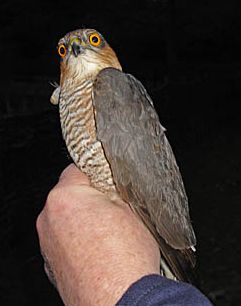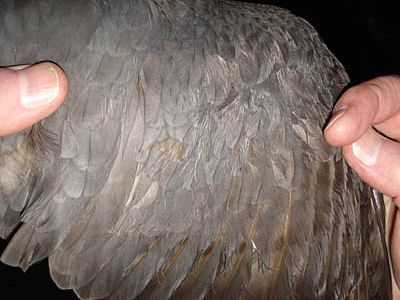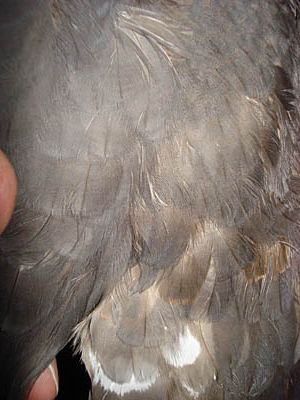Second-winter Sparrowhawks (28 February 2009)
The chance capture of two Sparrowhawks Accipiter nisus in two days prompted this photo-essay. Both were second-winter birds, hatched in 2007 (Euring age code 7, third calendar-year), easily aged by their retained juvenile secondaries and tail feathers. The male - on the left in all the images below - was caught in woodland, at a finch roost, and the photographs were taken with flash by Jeff Clarke; the female was caught the following day as she chased Collared Doves in my garden.
Their iris colour gives a helpful hint about their age: first-year birds have a pale lemon-yellow iris, which becomes deeper yellow, then orange as the birds get older. Males tend to be deeper in colour than females, and some old males can have a reddish iris. Ian Newton in his book 'The Sparrowhawk' (1986, T & A D Poyser) noted that 'the most consistent changes occurred between the first and second years ... In most females, the eyes remained yellow, even in the oldest individuals, though in a few they became pale orange.'
.jpg)
.jpg)
The images of the tail show that both birds had retained several juvenile feathers from 2007, browner and more abraded than the greyish rectrices grown in their moult in 2008. The retained feathers are not symmetrical within the tail: for the male, just r5 on the left side and r3 and r5 on the right side; the female has retained r1 and r5 on the left side, r1, r2 and r5 on the right side.
.jpg)
.jpg)
As well as the difference in colour, the juvenile feathers are more frayed at the tips: see, for example, r5 of the female bird:
.jpg)
Both hawks had retained some juvenile secondaries, shown on the images below of the right wing of the male and the left wing of the female. As with the tail, the unmoulted (juvenile) feathers are clearly a browner colour but are not particularly worn, presumably because they are quite sheltered from abrasion.
The male had retained, symmetrically on both wings, two juvenile secondary feathers (s5 and s8, counting ascendantly, from the centre of the wing towards the body). The female had six juvenile secondary feathers (ss3, 4 and ss6, 7, 8, 9). Sparrowhawks have 14 secondaries, the innermost four of which are the tertials. All raptors moult the secondaries from two or three centres, thus having only small gaps where the feathers are missing and enabling them to keep a high level of flight ability during their lengthy moult. As well as being browner, the retained juvenile secondary s5 on the male bird (below left) has a different shape compared to the moulted feathers. Juvenile secondary feathers are also slightly longer than their adult replacements.
.jpg)
.jpg)
I would be interested to know if there are any figures, but I suspect that retention of secondaries and rectrices for two years is becoming more frequent. Baker's Identification Guide to European Non-Passerines (BTO Guide 24, 1993) says ... 'sometimes an old tail feather or secondary retained', which implies that this is not common. I commented previously on another example.
Not all second-winter Sparrowhawks are as easy to age as these two, and we sometimes have to search for odd retained juvenile feathers on the rump (left), between the coverts and scapulars (centre; see also a previous example) and lesser and median coverts (right). All of these images are from the female depicted above:
.jpg)
.jpg)
.jpg)
These traits probably apply to all in the Accipiter family. The Sparrowhawk's north American relatives, Sharp-shinned Hawk Accipiter striatus and Cooper's Hawk Accipiter cooperii, are much smaller (Sharp-shinned) and bigger (Cooper's) than Sparrowhawks but otherwise similar in behaviour and in moult strategy. Pyle's Identification Guide to North American Birds Part II (Slate Creek Press, California, 2008) says ... '1-2 juvenile rectrices occasionally retained' and '1-6 juvenile secondaries amongst s3-s4 and s6-s9 occasionally retained'.
Sparrowhawks are powerful birds, with the females easily able to catch, and carry, birds almost as large as themselves such as Collared Doves Streptopelia decaocto. As with all the specialist bird-catching raptors, they have relatively long toes and comparatively short talons, well adapted for gripping and exerting considerable pressure on their prey.
.jpg)
Addendum
Ten days later, I caught a third Sparrowhawk, at a different site, Norton Priory, Runcorn, also another second-winter (male) bird. This was coming into a finch/ thrush roost, so the only photographs (taken by Jeff Clarke) are with flash.

This bird had no juvenile secondaries or rectrices, and proved to be one of those where we had to search amongst the contour feathers to find a few brownish ones with buff tips, retained juvenile feathers about 21 months old.


David Norman.